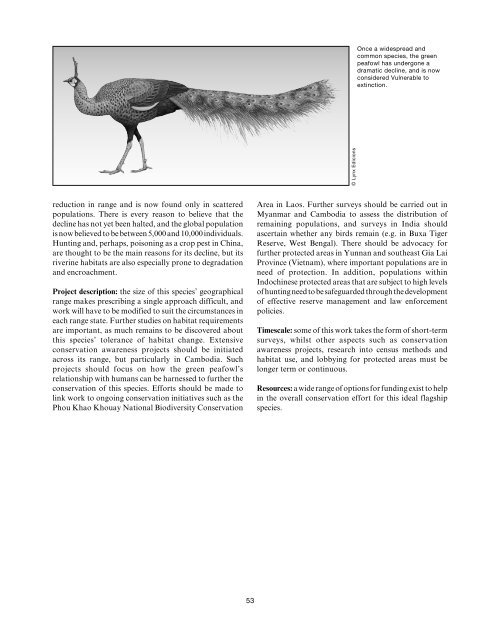Pheasants: Status Survey and Conservation Action Plan ... - IUCN
Pheasants: Status Survey and Conservation Action Plan ... - IUCN
Pheasants: Status Survey and Conservation Action Plan ... - IUCN
Create successful ePaper yourself
Turn your PDF publications into a flip-book with our unique Google optimized e-Paper software.
Once a widespread <strong>and</strong><br />
common species, the green<br />
peafowl has undergone a<br />
dramatic decline, <strong>and</strong> is now<br />
considered Vulnerable to<br />
extinction.<br />
© Lynx Edicions<br />
reduction in range <strong>and</strong> is now found only in scattered<br />
populations. There is every reason to believe that the<br />
decline has not yet been halted, <strong>and</strong> the global population<br />
is now believed to be between 5,000 <strong>and</strong> 10,000 individuals.<br />
Hunting <strong>and</strong>, perhaps, poisoning as a crop pest in China,<br />
are thought to be the main reasons for its decline, but its<br />
riverine habitats are also especially prone to degradation<br />
<strong>and</strong> encroachment.<br />
Project description: the size of this species’ geographical<br />
range makes prescribing a single approach difficult, <strong>and</strong><br />
work will have to be modified to suit the circumstances in<br />
each range state. Further studies on habitat requirements<br />
are important, as much remains to be discovered about<br />
this species’ tolerance of habitat change. Extensive<br />
conservation awareness projects should be initiated<br />
across its range, but particularly in Cambodia. Such<br />
projects should focus on how the green peafowl’s<br />
relationship with humans can be harnessed to further the<br />
conservation of this species. Efforts should be made to<br />
link work to ongoing conservation initiatives such as the<br />
Phou Khao Khouay National Biodiversity <strong>Conservation</strong><br />
Area in Laos. Further surveys should be carried out in<br />
Myanmar <strong>and</strong> Cambodia to assess the distribution of<br />
remaining populations, <strong>and</strong> surveys in India should<br />
ascertain whether any birds remain (e.g. in Buxa Tiger<br />
Reserve, West Bengal). There should be advocacy for<br />
further protected areas in Yunnan <strong>and</strong> southeast Gia Lai<br />
Province (Vietnam), where important populations are in<br />
need of protection. In addition, populations within<br />
Indochinese protected areas that are subject to high levels<br />
of hunting need to be safeguarded through the development<br />
of effective reserve management <strong>and</strong> law enforcement<br />
policies.<br />
Timescale: some of this work takes the form of short-term<br />
surveys, whilst other aspects such as conservation<br />
awareness projects, research into census methods <strong>and</strong><br />
habitat use, <strong>and</strong> lobbying for protected areas must be<br />
longer term or continuous.<br />
Resources: a wide range of options for funding exist to help<br />
in the overall conservation effort for this ideal flagship<br />
species.<br />
53
















